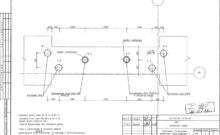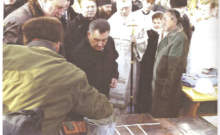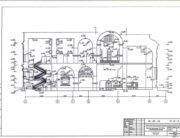Conducting studies of the ruins of the Assumption Cathedral N. V. Kholostenko revealed: “an altar mounted on a wooden frame made of copper sheets With silver lining – inserts of bas-reliefs and stripes of an ornament with an altar of seven thousand sixty four. The altar revealed pidvalina with plinfy, lined XIX century. Brick stinky … In the corners of the altar vistlennya found the bottom of four slate pillars, the top of which is seen as a bit. Poles small quarter-grooves for filling plates. Obviously, these are the remains of an ancient altar, about in design to the original throne, described in the “Pechersk Paterik.”
Excavations of 1962-63 Revealed: “… the northern wall of the Stefanivskogo limit. In the break of this wall, it was found that the wall here is 2 meters thick, the dismantling of the dam and internal bookmarks revealed the degrees of the internal staircase, located in the thickness of the northern wall and the transverse pre-altar wall. The staircase led, perhaps, to the sacristy above the altar of the Stephanie limit. The final disassembly of the bookmark opened a small platform at the bottom of the stairs, 85 cm wide and about 1 m long and 8 steps of the stairs. The steps are made of bricks. Their laying is tied with a laying of walls, that is, the inside-wall staircase was constructed simultaneously with the construction of the walls of the Stefanivsky limit. The width of the staircase is 73 cm. The risers are 28-38 cm, the treads are 30-41 cm. The treads were covered with planks, and the treads of the 2 surviving degrees were slate slabs … This is the initial mosaic floor plate of the cathedral, taken from the floor during repair and laid in the masonry intra-wall ladder. ”
As a result of the study of the cathedral in 1952, it was established that wooden ties were rooted at the level of the heels of the vault.
According to the results of recent petrographic and microchemical studies of the remains of the cathedral, which are supplemented by preliminary information and historical evidence, seven construction periods can be seen in the construction of the Assumption Cathedral. In the First period, the ancient Russian core of the church was erected: a six-column trio-shaped papilio-paprio cathedral with a baptismal facade in front of the northern cathedral’s facade, at its North-Western corner, at the same time long-lasting work on the superstructure and repair of the cathedral, which did not significantly change its appearance . At another period, to the western facade, on the South side, was a chapel attached above the grave of Princess Eupraxia. Repair work continued in the third period of the building history of the Assumption Cathedral.
If the first, second and third periods are associated with princely clocks and the Middle Ages, the fourth period began during the Renaissance (revival) in Ukraine, and ended already during the domination of the Baroque style. It was in the fourth period that a significant renovation of the buildings of the Pechersky Monastery took place, at the same time Stefanivsky annexed to the Assumption Cathedral from the northern side, the Eltsev Chapel was completed in the eastern wall of the John the Baptist Church. The fifth building period of the Baroque era is related to the expansion and restructuring of the Assumption Cathedral, changing the number and shape of baths, changing the shape of the chapels, which were completed according to the general spatial concept of the cathedral, which, on the contrary, remained medieval. As of the mid-17th century, the cathedral had high vaults and nine high baths and tops, the central Zakomara curled on two slopes and was crowned with a drum with a dome. The crest-room was crowned by a bathhouse with eight windows. on engravings, the performance after 1651, it is clear how the roof forms were made, the completion of the chapel to Princess Ezpraksiya, and in 1677, in front of the western facade, north of the western entrance to the cathedral, two small chapels appeared. At the same time was built on Three Saints came.
The peculiarity of the fifth construction period is that although it is chronologically related to the times of the Baroque, the general architectural composition of the cathedral remains medieval.
But in the sixth period of the Baroque era, the general concept of architecture of the Assumption Cathedral begins to fade, the small division of the western facade with chapters disappears, which are combined into a total volume, the Three-Holy Limit becomes monumental, harmoniously eaten with the architecture of St. John the Baptist baptismal.
The most significant of those periods that chronologically belong to the Baroque era in Ukraine is the seventh, last period. It was during this period after the fire of 1718 that the overall architectural and spatial concept of the cathedral changed as a result of the carried out repair work: all the side doors were united in the volume of a two-tier building, closed in terms of a single perimeter. In the seventh period, the Assumption Cathedral acquired the completed form of the baroque temple. During the repair and simultaneous reconstruction, Ioanno-Theological and Stefanivskyy were rebuilt and expanded, and the entrance parts from the south and north were built, as a result of which the cathedral received a rectangular contour, in which the semicircular apses and faceted apses of Ioanno- Theological and Stefanivsky pridiliv.



















